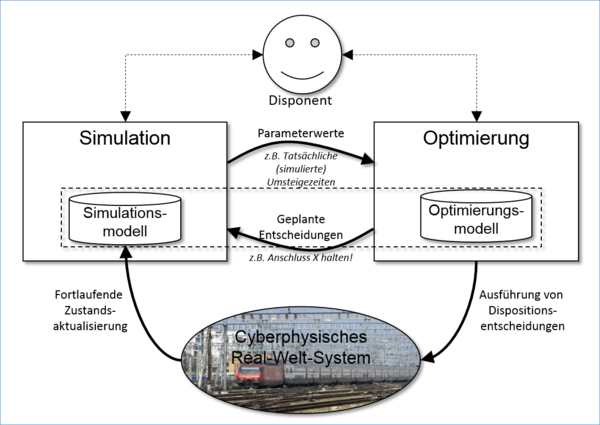ASimOV: Agent-based simulation of passenger behavior to optimize the delay management in rail transport
ASimOV: Agent-based simulation of passenger behavior to optimize the delay management in rail transport
Delay management of railway operations decides how to react to delays of individual trains. One of the dispatching decisions to be made is to determine whether a connecting train should wait for a delayed feeder train or if it is better to depart on time. Similarly, priority decisions have to be taken in case several trains compete for the same track section concurrently.
Using agent-based modeling and simulation (ABMS), the ASimOV1 project investigates and analyzes the effect of the passengers' behavior during changeovers between trains and its influence on delay management strategies.

Motivation and technical background
For about ten years the delay management problem has been theoretically analyzed and good dispatching strategies have been developed. However, a couple of simplifications are necessary in existing solutions. These include a macroscopic representation of the infrastructure network as well as simplifying assumptions on the passengers' behavior. While simulation-based approaches already exist for determining the track occupation of trains within the delay management problem, the effect of passenger behavior has not yet been investigated. Dependencies between the passenger behavior and train delays emerge especially at train stations: In case of a tight connection, passengers alight quicker and run to their connecting train's planned platform; this happens even if they have been announced that the corresponding train cannot be reached anymore. When a connection cannot be maintained, some passengers try to receive information from a display panel or an information counter. Others might stroll through the shops in the station hall. Passenger behavior can cause additional delays: A train can only depart once there are no more boarding passengers - the sequential arrival of passengers stepping in one after the other can hence defer a train's departure.
Within the last years we have witnessed a paradigm shift with respect to the modeling and simulation of complex traffic and transportation networks and systems. Macroscopic approaches which model flows as differential equations and uncertainties by means of stochastic models are increasingly being extended (sometimes even replaced) by microscopic approaches. Agent-based modeling and simulation is such a microscopic paradigm and has been successfully applied within the last years in the area of mobility simulations -- particularly for demand models. Most of the available models and platforms use simple agent models which have only limited ability in displaying complex cognitive and interactive behavior. Current challenges include computational performance and scalability of agent-based platforms. These aspects are crucial for an efficient deployment on parallel architectures and an efficient linking of different sub-models.
Goals of the project
A major challenge in this project lies in connecting two heterogeneous simulation models within the context of an optimization task: the macroscopic simulation of trains in the infrastructure network and the microscopic simulation of passengers in the railway station to form a scalable and efficient overall simulation system.
The ABMS will be used to analyze the effect of passenger behavior on train delays and the dispatching in general. Different influencing factors, such as goals and preferences of the passengers, their behavior during changeovers between trains, and the degree of information will be modeled and studied. This will enable us to test existing dispatching strategies and to develop new ones by using the simulation. Finally, the simulation methodology will be extended to an iterative hybrid process which runs the simulation and the optimization steps alternately. This process makes it possible to use information from the simulation within the optimization and vice versa. In this way we intend to provide optimized solutions which are also performing well in simulated realistic scenarios.
1Isaac Asimov, born 1920, died 1992; Biochemist, book author and one of the most well-known Science-Fiction-Authors in his days.